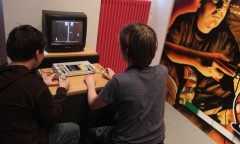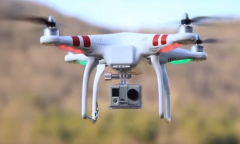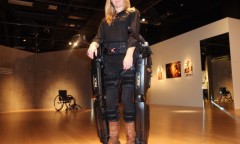By Iesha Javed, | September 19, 2016

Krishna Shinoy demonstrates how the Stanform brain machine interface functions.
With the help of brain sensing technology, scientists have been able to create a device that reads and converts signals from neurons in one's brain into electric signals that can be understood as instructions by a computer. The Stanford Brain-Machine Interface has been successfully tested with monkeys.
Like Us on Facebook
The technology could potentially lead to the development of a system which can be used in prosthetics and other mind-controlled gadgets.
Krishna Shenoy, a professor of electrical engineering at Stanford University, and Paul Nuyujukian, a researcher in bioengineering, developed the technology which can read a person's mind and type the alphabets they are thinking about. The technology is particularly promising for speech impaired persons who may now be able to have meaningful conversations with the help of a keyboard attached to the BMI.
The researchers have successfully tested the technology on monkeys who were trained to use a touchscreen. When given passages of written text, the BMI could successfully interpret the signals from their brain to instruct the keyboard to type the relevant alphabets. The experiments demonstrated that a typing speed of up to 12 words could be easily achieved with the system.
Although similar technologies have been used in mind-controlled bionic devices, prosthetic limbs, and wheelchairs, the use of the technology for communication was not very impressive given the sluggishness and imprecise results. However, with these advances made by researchers at Stanford, mind-controlled communication and typing is expected to become much more efficient.
In April, researchers developed a system capable of hosting a mind-controlled drone race. The University of Florida hosted the historic event where drone pilots were supposed to fly their drones across a distance of 30 feet using merely their cognitive abilities and mental endurance. The competition, which was made possible by a brain-computer interface (BCI), is just the beginning with major advances expected at the Global Cybathon in October where competitors will show off futuristic bionic gears.
-
Use of Coronavirus Pandemic Drones Raises Privacy Concerns: Drones Spread Fear, Local Officials Say

-
Coronavirus Hampers The Delivery Of Lockheed Martin F-35 Stealth Fighters For 2020

-
Instagram Speeds Up Plans to Add Account Memorialization Feature Due to COVID-19 Deaths

-
NASA: Perseverance Plans to Bring 'Mars Rock' to Earth in 2031

-
600 Dead And 3,000 In The Hospital as Iranians Believed Drinking High-Concentrations of Alcohol Can Cure The Coronavirus

-
600 Dead And 3,000 In The Hospital as Iranians Believed Drinking High-Concentrations of Alcohol Can Cure The Coronavirus

-
COVID-19: Doctors, Nurses Use Virtual Reality to Learn New Skills in Treating Coronavirus Patients













